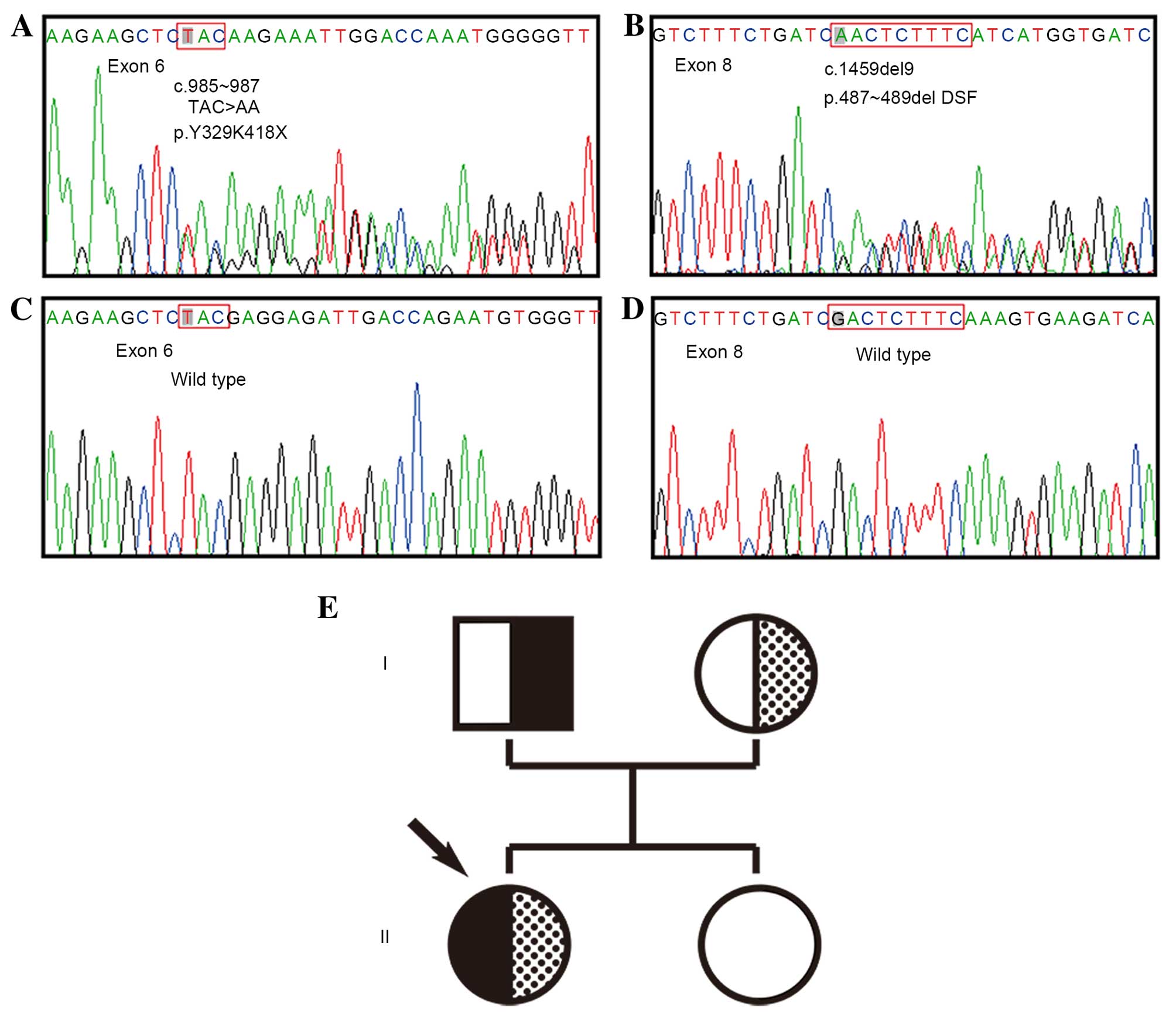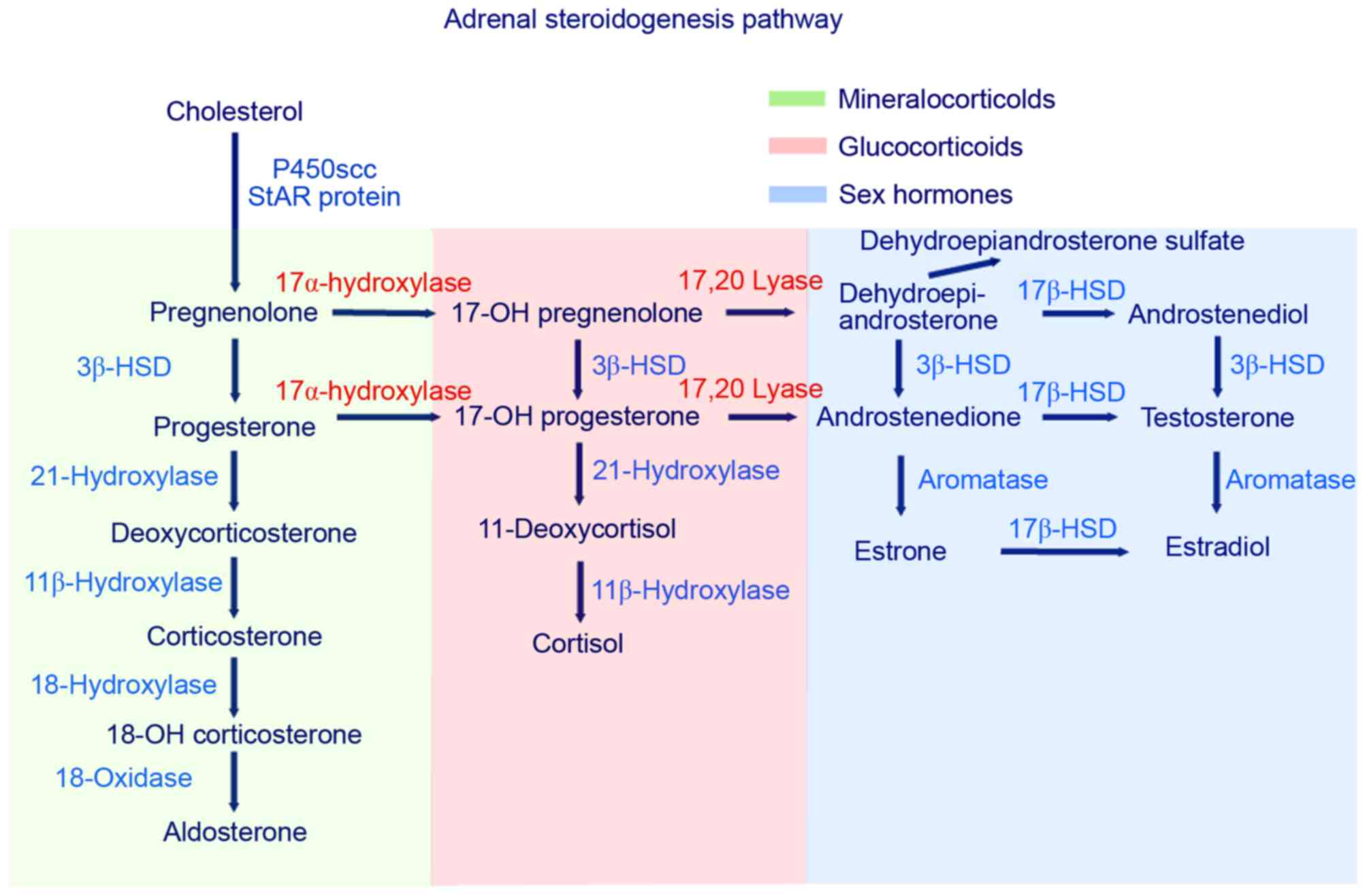|
1
|
Honour JW: Diagnosis of diseases of
steroid hormone production, metabolism and action. J Clin Res
Pediatr Endocrinol. 1:209–226. 2009. View Article : Google Scholar : PubMed/NCBI
|
|
2
|
Miller WL and Auchus RJ: The molecular
biology, biochemistry, and physiology of human steroidogenesis and
its disorders. Endocr Rev. 32:81–151. 2011. View Article : Google Scholar : PubMed/NCBI
|
|
3
|
Krone N and Arlt W: Genetics of congenital
adrenal hyperplasia. Best Pract Res Clin Endocrinol Metab.
23:181–192. 2009. View Article : Google Scholar : PubMed/NCBI
|
|
4
|
Biason-Lauber A, Boscaro M, Mantero F and
Balercia G: Defects of steroidogenesis. J Endocrinol Invest.
33:756–766. 2010. View Article : Google Scholar : PubMed/NCBI
|
|
5
|
Auchus RJ: The genetics, pathophysiology,
and management of human deficiencies of P450c17. Endocrinol Metab
Clin North Am. 30101–119. (vii)2001.PubMed/NCBI
|
|
6
|
Miller WL: Androgen synthesis in
adrenarche. Rev Endocr Metab Disord. 10:3–17. 2009. View Article : Google Scholar : PubMed/NCBI
|
|
7
|
Miller WL: Steroid 17alpha-hydroxylase
deficiency-not rare everywhere. J Clin Endocrinol Metab. 89:40–42.
2004. View Article : Google Scholar : PubMed/NCBI
|
|
8
|
Oh YK, Ryoo U, Kim D, Cho SY, Jin DK, Yoon
BK, Lee DY and Choi D: 17alpha-hydroxlyase/17, 20-lyase deficiency
in three siblings with primary amenorrhea and absence of secondary
sexual development. J Pediatr Adolesc Gynecol. 25:e103–e105. 2012.
View Article : Google Scholar : PubMed/NCBI
|
|
9
|
Miller WL: Congenital adrenal
hyperplasias. Endocrinol Metab Clin North Am. 20:721–749.
1991.PubMed/NCBI
|
|
10
|
Kater CE and Biglieri EG: Disorders of
steroid 17 alpha-hydroxylase deficiency. Endocrinol Metab Clin
North Am. 23:341–357. 1994.PubMed/NCBI
|
|
11
|
Yanase T, Simpson ER and Waterman MR: 17
alpha-hydroxylase/17,20-lyase deficiency: From clinical
investigation to molecular definition. Endocr Rev. 12:91–108. 1991.
View Article : Google Scholar : PubMed/NCBI
|
|
12
|
Biglieri EG, Herron MA and Brust N:
17-hydroxylation deficiency in man. J Clin Invest. 45:1946–1954.
1966. View Article : Google Scholar : PubMed/NCBI
|
|
13
|
Matteson KJ, Picado-Leonard J, Chung BC,
Mohandas TK and Miller WL: Assignment of the gene for adrenal
P450c17 (steroid 17 alpha-hydroxylase/17,20 lyase) to human
chromosome 10. J Clin Endocrinol Metab. 63:789–791. 1986.
View Article : Google Scholar : PubMed/NCBI
|
|
14
|
Picado-Leonard J and Miller WL: Cloning
and sequence of the human gene for P450c17 (steroid 17
alpha-hydroxylase/17,20 lyase): Similarity with the gene for
P450c21. DNA. 6:439–448. 1987. View Article : Google Scholar : PubMed/NCBI
|
|
15
|
Miller WL: The syndrome of 17,20 lyase
deficiency. J Clin Endocrinol Metab. 97:59–67. 2012. View Article : Google Scholar : PubMed/NCBI
|
|
16
|
Turcu AF and Auchus RJ: The next 150 years
of congenital adrenal hyperplasia. J Steroid Biochem Mol Biol.
153:63–71. 2015. View Article : Google Scholar : PubMed/NCBI
|
|
17
|
Goldsmith O, Solomon DH and Horton R:
Hypogonadism and mineralocorticoid excess. The 17-hydroxylase
deficiency syndrome. N Engl J Med. 277:673–677. 1967. View Article : Google Scholar : PubMed/NCBI
|
|
18
|
Larson A, Nokoff NJ and Travers S:
Disorders of sex development: Clinically relevant genes involved in
gonadal differentiation. Discovery medicine. 14:301–309.
2012.PubMed/NCBI
|
|
19
|
Philip J, Anjali, Thomas N, Rajaratnam S
and Seshadri MS: 17-Alpha hydroxylase deficiency: An unusual cause
of secondary amenorrhoea. Aust N Z J Obstet Gynaecol. 44:477–478.
2004. View Article : Google Scholar : PubMed/NCBI
|
|
20
|
Kim YM, Kang M, Choi JH, Lee BH, Kim GH,
Ohn JH, Kim SY, Park MS and Yoo HW: A review of the literature on
common CYP17A1 mutations in adults with 17-hydroxylase/17,20-lyase
deficiency, a case series of such mutations among Koreans and
functional characteristics of a novel mutation. Metabolism.
63:42–49. 2014. View Article : Google Scholar : PubMed/NCBI
|
|
21
|
Zhang M, Sun S, Liu Y, Zhang H, Jiao Y,
Wang W and Li X: New, recurrent and prevalent mutations: Clinical
and molecular characterization of 26 Chinese patients with
17alpha-hydroxylase/17,20-lyase deficiency. J Steroid Biochem Mol
Biol. 150:11–16. 2015. View Article : Google Scholar : PubMed/NCBI
|
|
22
|
Hahm JR, Kim DR, Jeong DK, Chung JH, Lee
MS, Min YK, Kim KW and Lee MK: A novel compound heterozygous
mutation in the CYP17 (P450 17alpha-hydroxylase) gene leading to
17alpha-hydroxylase/17,20-lyase deficiency. Metabolism. 52:488–492.
2003. View Article : Google Scholar : PubMed/NCBI
|
|
23
|
Fardella CE, Zhang LH, Mahachoklertwattana
P, Lin D and Miller WL: Deletion of amino acids
Asp487-Ser488-Phe489 in human cytochrome P450c17 causes severe 17
alpha-hydroxylase deficiency. J Clin Endocrinol Metab. 77:489–493.
1993. View Article : Google Scholar : PubMed/NCBI
|
|
24
|
Kim SM and Rhee JH: A case of 17
alpha-hydroxylase deficiency. Clin Exp Reprod Med. 42:72–76. 2015.
View Article : Google Scholar : PubMed/NCBI
|
|
25
|
Marsh CA and Auchus RJ: Fertility in
patients with genetic deficiencies of cytochrome P450c17 (CYP17A1):
Combined 17-hydroxylase/17,20-lyase deficiency and isolated
17,20-lyase deficiency. Fertil Steril. 101:317–322. 2014.
View Article : Google Scholar : PubMed/NCBI
|
|
26
|
Levran D, Ben-Shlomo I, Pariente C, Dor J,
Mashiach S and Weissman A: Familial partial 17,20-desmolase and
17alpha-hydroxylase deficiency presenting as infertility. J Assist
Reprod Genet. 20:21–28. 2003. View Article : Google Scholar : PubMed/NCBI
|











